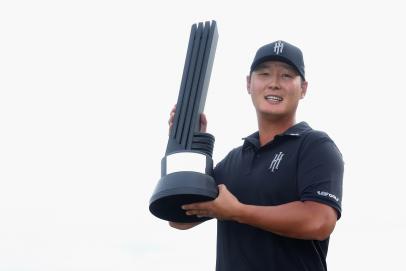Editor's Note: This article first appeared in Fire Pit Collective, a Golf Digest content partner.
TUCSON, Ariz. — It is always fascinating to observe professional golfers in their non-native environment, and on the eve of LIV Tucson, the Dove Mountain Ritz-Carlton provided ample material for the curious anthropologist. Parked out front was Paul Casey’s pimped-out black Porsche GT3 RS with gold wheels and a customized Arizona State license plate; the Scottsdale resident had driven from home, presumably at 180 mph. In the hotel lobby, Jason Kokrak made the scene in a plaid flannel like a roadie for Soundgarden, circa 1993. In his jeans, puffer vest and Oxford shirt, a graying Charles Howell III looked like a visiting lecturer at a community college. Numerous players milled around, showing off a variety of Air Jordans and flip-flops, backward baseball caps and receding hairlines. The lobby was also alive with khaki-clad agents, with their telltale leather-encased notebooks, and a phalanx of hot blondes, including Paulina Gretzky spilling out of a micro mini-dress. Cam Smith and Jediah Morgan were tossing around a rugby ball. Harold Varner III approached a random kid and tickled him without ever breaking stride. Pat Perez strolled by a couple of dour cops and said, “At ease, gentlemen. At ease.”
The insouciant vibe was at odds with the growing pains LIV is currently experiencing. The players had gathered in a Ritz ballroom for a mandatory meeting led by commissioner Greg Norman and chief operating officer Gary Davidson. Among the topics addressed were the coming drug-testing procedures and a new pace-of-play policy, of which one player says, in a tone as dry as the Sonoran desert, “It’s basically modeled on the [PGA] Tour’s, so expect it to be just as effective.” But the biggest revelation of the night was the ongoing evolution of LIV’s business model, which has led to a certain amount of behind-the-scenes consternation. Louis Oosthuizen, captain of the all-South African Stinger squad, is one of the most mild-mannered folks in golf, but he was utterly flummoxed when approached (the following day) for comment about the meeting. “Sorry mate, I don’t want to talk about any politics or any controversy,” he said.
At the heart of the matter is LIV’s accelerated timeline. Its executives refer to 2023 as Year 1, and the original plan was to hold 10 tournaments this season and introduce the fully baked-out team component in 2024 as part of a slate of 14 events. But internally, the beta test season of 2022 was judged a monumental success, based on the buzz created by the breakaway league—almost all of it was about the macro stories and not the competition, but disregard that for now—and the signing of so many Hall of Famers, Ryder Cup stars, major champions and U.S. Amateur winners. During a tumultuous offseason, LIV decided to fast-track its business plan by a full year, conducting 14 tournaments in ’23 and going all-in on the team concept, which has palpably bonded and energized its players. LIV desperately needs to build fan interest and differentiate itself from the PGA Tour, and the team component is its best selling point. But now some players’ expectations, and contracts, are misaligned with what’s best for the league as a whole. A hint at the related palace intrigue was the abrupt resignation last November of president and COO Atul Khosla.
Says one player, “Some guys thought their contracts for this year are for 10 tournaments, not 14. But even with more tournaments there is no bump in the guaranteed money they signed for. Last year the players kept their share of the team winnings”—Pat Perez famously won more than $8 million on the season despite an average individual finish of 32nd—“but now that money goes back to the team. I heard one guy say, ‘Why are we standing on a podium spraying each other with champagne when we don’t get the money?’ So that’s interesting. And now there is talk that [LIV leadership] wants to put more of the total purse toward the team component. But, again, guys have it in their contract they would be playing for $20 million on their own. So you can imagine there is a lot of conversation right now.”
It is often said that LIV has unlimited resources, so shouldn’t all of this be easily solvable with more barrels of money? LIV could just add $10 million to each purse for the team component and everyone would be happy, right?
One LIV executive counters that its financial forecasting extends for 10 years, so a purse increase of only $2 million per tournament quickly becomes a $250 million expense that has to go into the model.
“Jay Monahan himself said this is an arms race the PGA Tour can’t win, so let’s win the arms race,” says the player. “But that isn’t the climate out here anymore.”
Indeed, the most important barometer is the press room lunch: Last year featured decadent buffets with hot entrees and a cornucopia of desserts, but in Tucson it was the same cold sandwiches and pre-packaged cookies day after day. OK, that’s not the most important barometer, but it is symptomatic of larger belt-tightening. To get things off the ground in 2022, LIV covered all of the travel expenses for the players and (most of) their entourages, but now those costs have been offloaded to each team. That decision might be traced to the pique of His Excellency Yasir al-Rumayyan, the governor of Saudi Arabia’s Public Investment Fund, which pays all of LIV’s bills. (Al-Rumayyan is also chairman of Saudi Aramco, which reported a $161 billion profit in 2022.) Norman is the frontman, but al-Rumayyan, who is often referred to internally at LIV as “The Investor,” is calling the shots. Last year he provided a deluxe 747 charter to ferry players from LIV Portland to the JP McManus Pro-Am in Ireland but was furious when social-media posts made the plane look like a flying frat party. There are no chartered jets this year. Al-Rumayyan and his deputy, Majed al-Sorour, were omnipresent at the LIV events last year, bro-hugging their way through the pro-ams and hosting Tuesday night player parties with fancy wines. But they have been noticeably absent this year, a signal they are now treating LIV more like a business and not a fantasy camp for weekend hackers with PIF money.
“Every expense is getting double- and triple-checked now,” says another player. “Just take a look at the musical acts.” Last year LIV hosted post-round concerts for fans featuring headliners including Diplo, Jason Durelo, Nelly and, not least, the Chainsmokers, stolen away from the warm embrace of the PGA Tour. On Friday in Tucson, the music came courtesy of a DJ with minimal star power.
All of this is not to say that LIV is unwilling to pour more money into its product in its ongoing war of attrition with the PGA Tour. “When we committed to $25 million purses two years ago, that was by far the biggest in the game,” the executive says. “Now the Players Championship purse is $25 million and other tour events are at $20 million. So that’s something that we are looking at and will continue to evaluate.”
If the purses grow, it seems certain the money will be applied to the team component. “It would maximize the team values,” says the exec, “because their valuations are based on revenue. From a pure business point of view, it would have made more sense from the very beginning to put all of the purse toward the teams [as LIV does now with its season-ending $50 million extravaganza]. But that would have been a vast departure from what the world of golf has known forever, and we wouldn’t have been able to sign all the players. In time we may move in that direction—we’re fluid on that.”
That will only be possible when enough existing player contracts expire or are restructured. A handful of the biggest stars have contracts through 2026 or ’27, but otherwise, says a second LIV executive, “There aren’t as many multi-year deals as people think.”
LIV owns 75 percent of each franchise, with the remaining equity spread among the players, primarily the captains. Last fall, al-Rumayyan said his goal is for the Public Investment Fund to reach $1 trillion in assets under management by 2025, and that kind of growth doesn’t happen by making bad bets. Selling the 12 team franchises for nine figures apiece is crucial to LIV’s financial outlook; they are expected to go up for sale for next year, once the P&Ls look more sound. Because of the accelerated timeline on launching the team component, LIV gave each franchise a line of credit to help cover expenses this year, which, in addition to travel costs, includes paying social-media staffers, team managers, branding experts and financial advisers. (The loan comes at the minimum interest rate required by federal law.) Three teams have already locked down corporate sponsorships deals, although the details have not yet been announced as the logos and messaging gets finalized. (Keep an eye on the sleeves of the players’ polos.)
With only the top three teams being paid at each tournament, struggling squads like the Majesticks and the Cleeks could easily be in the red at year’s end. At the players meeting at the Ritz, LIV leadership introduced the notion of spreading out the $5 million team purse to the top five finishers, an idea that had been hashed out during a captains-only meeting last month at LIV Mayakoba. Casey, sitting in the back of the room, generated some laughs when he raised his hand and asked, “Is that retroactive?” It’s not; his Crushers won the team title last month at the season-opening event in Mayakoba (above) and they won’t have to spread the wealth. Neither will the Fireballs, who prevailed in Tucson thanks in part to the strong play of Carlos Ortiz, who, on the individual leaderboard, lost in a playoff to Danny Lee, 32. (The Fireballs feature three other players whose native tongue is Spanish: Sergio Garcia, Abe Ancer and Eugenio Lopez-Chacarra.)
Lee (photo at top of story) is a previous winner on the PGA and DP World Tours, to say nothing of the U.S. Amateur. In just his second LIV start, he earned his first worldwide victory since 2015. “I felt like winning is not my thing but today changed that,” a choked-up Lee said. He credited the team dynamic with getting him across the line, saying, “Honestly I wasn’t even looking at the individual scores all day, I was only asking how our team is doing. It’s the reason why [Ironheads captain Kevin Na] called me and why I wanted to come over here, to win as a team. It’s better for me mentally because I can’t ever give up on one shot out here because the team is watching.” The individual victory was worth $4 million, a milli more than the first-place team split.
“I think we need to go harder with the team thing,” says Cam Smith, captain of the all-Aussie Rippers. “I would be in favor of giving more of the purse to the teams, absolutely. [The captains] have a discussion every couple of weeks. It’s a cool thing that as players our voices are heard.”
Na offered some needed perspective when he described the discord as “first-world problems.” He was unbothered by any proposed changes to how the money gets doled out, saying he’s not even sure what is specified in his contract. “It’s a long contract!” he says with a laugh. “I’ll have to ask my agent.” In the perfect coda to this moment in professional golf, Na adds, “There is a shit-ton of money out here, and I already got a shit-ton. If you play well, you’re gonna win a shit-ton more. I’m not worrying about the details.”



